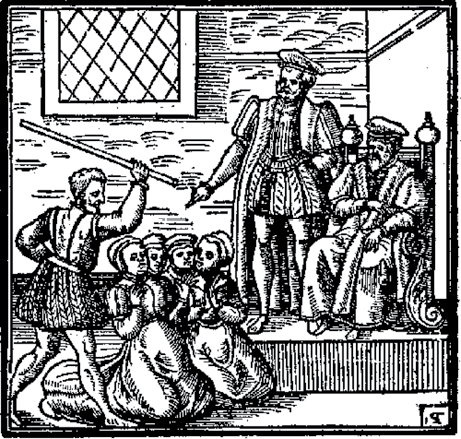

Cleveland Comhrá: The Witches of Islandmagee
By Bob Carney
Most of us are familiar with America’s storied past when it comes to witchcraft. In early 1692 to mid 1693, over two-hundred people were accused of practicing witchcraft in Salem, Massachusetts. Thirty were found guilty and twenty were executed for their purported crimes.
Today historians believe the accusations were the result of a combination of teenage mischief and imaginations, hysteria and the Puritans strict religious bias’ and beliefs, that led to the acceptance of the accusations.
The last person to be executed was Irish born Anne (Goody) Glover, her biggest crime was not being fluent in English. Irish was her first language. Prior to her conviction, she had taken care of many in the community.
Arthur Miller resurrected the story of the Salem Witch Trials in his 1953 play, The Crucible, using the trials as an apologue to McCarthy’s anti-communist campaign. True or not, it could be a death sentence for your career and reputation if you were labeled a witch.
Europe experienced a plague of witchcraft accusations and trials as well, and Ireland was no exception. Paganism and Christianity sometimes clashed. Other times parts of each were incorporated into one’s own beliefs.

Witchcraft
There is a great song by the local Celtic rock band, Marys Lane, called, “Petronilla,” that tells a romanticized version of the story of Petronilla de Meath, the maid servant of Dame Alice Kytelar, a noble woman in what is now Co. Kilkenney. After the death of Kytelar’s fourth husband, she and Petronilla were accused of practicing witchcraft and of causing the deaths of their husbands. Dame Alice fled, but Petronilla was tortured and then burned at the stake on November 3, 1324, becoming one of the first recorded instances of a trial in Ireland for witchcraft.
In 1578, two more were accused of being witches in Kilkenney and executed. In 1586, The Irish Witchcraft Act was passed, defining what practicing witchcraft entailed and outlining the punishments that could be inflicted.
In 1661, a woman named Florence Newton was convicted and executed for causing demonic possession of a woman and of using witchcraft to kill her jailer. The law wasn’t always used, in Co. Antrim in the year 1698, an elderly woman was strangled and burned by a mob for bewitching a nine year-old girl.
The last mass witch trial in Ireland took place in Carrickfergus, Co. Antrim. Eight women were put on trial for bewitching an eighteen-year-old girl in the village of Islandmagee.Ann Haltridge was an elderly woman living with her son James, his wife, their two children and servants. In the month of September of 1710, Ann began complaining of mysterious pains and claimed she was being haunted by demons.
Demons
A demon boy visited Ann in December. Her story is collaborated by her servant. In February of 1711, the demon boy returned, this time stones and turf were thrown at the house and windows were broken. No one was visible during the barrage.
The Reverend Robert Sinclair was called to investigate. He and a few of the church elders stayed in the house. They witnessed bed clothes in Ann’s room arranged to resemble a corpse.
Ann was too frightened to return to her room and moved to another room in the house. She becames bed-ridden and was in constant pain. She died on February 22, at noon. Rumours immediately spread that her death and haunting were caused by witches.
Four days after Ann’s death, James’ sister arrived to keep his wife company while James traveled to Dublin on business. Accompanying his sister was their teenage cousin, Mary Dunbar.
Mary has been described as bright and articulate, the result of her upbringing and education. During their first night in the house, they came across an apron tied up tightly with string with five unusual knots holding it together. They feared it to contain a charm or spell and were fearful to open it, all except Mary.
She carefully untied the apron and found Ann’s missing cap, lost for over a week before she passed. The next morning, Mary climbed the stairs to Ann’s old room and found the bed clothes stripped from the bed and thrown about the room. She returned about an hour later, but when she approached the landing, she was struck by severe pain in her thigh and fell screaming in agony.
She was carried down the stairs, where she seemed to recover, but then became overcome with pain throughout her body. She was put in her bed and over the next nine hours suffered a series of convulsions.
During the last hour of her ordeal, she began shouting violently at some unseen being. Finally settling down, she began to swoon, repeating “so and so.” When the other women in the house questioned her about it, she replied that a woman with a dirty face had come to her, along with several others.
Possessed
With Mary’s education and knowledge of religion, classical literature and language, we can only imagine the effect of her story on her listeners. She convinced the others that witchcraft was to blame for her haunting and Ann’s death.
On the first of March, Dunbar accused Janet Carson of her possession. Shortly after, she was “visited” by two more witches, visible only to herself, and named them. The next day, Janet Liston and her daughter, Elizabeth Sellor, were brought to the house so Mary could identify them. Reverend Sinclair and his associate tested them on their Christian faith and they were held for trial.
The mayor of Carrickfergus took over the investigation and Dunbar incriminated three other women. Mayor Clements didn’t hesitate and had the woman taken into custody.
Mary’s health improved immediately, but a couple of days later she relapsed and accused two others of attacking her, a woman called Mistress or Mrs. Ann and a woman with one eye. The hunt for those two resulted in the arrest of two more women.
During pre-trial interviews, Mary said the witches told her they planned on bewitching other members of the Haltridge family. The mayor set a date for the trial to be held in Carrickfergus.
On March 25, Dunbar lost her ability to speak, but it returned to her upon reading the bible. Four days later, she traveled to Carrickfergus, where she was a witness. She was confronted on the way by the spectres of a man and two women, who told her they would remove her power of speech so she couldn’t testify.
Even without Mary Dunbar’s testimony, the eight women were tried and convicted under the Irish Witchcraft Act of 1586. Mary returned to her mother’s home and continued to experience fits and seizures. She claimed that William Sellor, the husband of Elizabeth, visited her in the form of a spirit and stabbed her with a butcher knife. He was arrested and convicted of bewitching her.
Some forty thousand people were executed across Europe, England and Ireland for witchcraft, most of them were women. Academics from the University of Ulster teamed up to bring the Islandmagee Witchcraft Trial to light.
Dr. Andrew Sneddon, one of the leaders of the project, is an authority on the history of witchcraft and magic, said: “We have a timeless fascination with witches and witchcraft. It’s easy to forget that it was a crime in most places in Europe untill the 18th century, when an accusation of witchcraft could have terrible consequences.
People are more likely to accuse people of witchcraft in times of political, economic and religious crisis. There’s a need to find an explanation in the supernatural when crisis looms and old certanties disappear, and that’s as true today as it was in 18th century Ireland.”
*Bob Carney is a student of Irish languge and history and teaches the Speak Irish Cleveland class held every Tuesday at PJ McItyre’s. He is also active in the Irish Wolfhound and Irish dogs organizations in and around Cleveland. Wife Mary, hounds Rían, Aisling and Draoi and terrier Doolin keep the house jumping. He can be reached at [email protected].


Monthly newsmagazine serving people of Irish descent from Cleveland to Clearwater. We cover the movers, shakers & music makers each and every month.
Since our 2006 inception, iIrish has donated more than $376,000 to local and national charities.
GET UPDATES ON THE SERIOUS & THE SHENANIGANS!